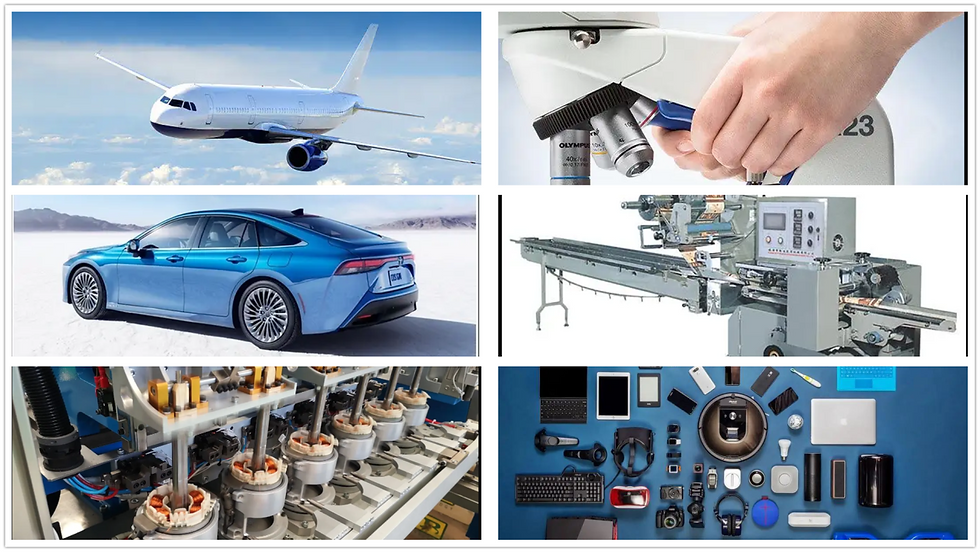Plastic Injection Molding: The Ultimate Guide to High-Volume Manufacturing
- shiva ganesh
- Jul 24
- 4 min read
Table Of Content
Introduction to Plastic Injection Molding
What is Plastic Injection Molding?

Plastic Injection Molding is a highly efficient manufacturing process used to produce large volumes of identical plastic parts with excellent precision, consistency, and durability. It involves injecting molten thermoplastic material into a precisely machined mold, where it cools and solidifies into the desired shape.
This process is widely utilized in industries like automotive, consumer electronics, medical devices, packaging, and appliances, where consistency, scale, and durability are crucial.
A Brief History of Plastic Injection Molding
Developed in the late 1800s, early injection molding machines focused on simple parts like buttons and combs. By the 1940s-50s, advancements in thermoplastics and automated tooling transformed it into a key technology for mass production. Today, it supports everything from precision medical components to complex automotive parts.
How Plastic Injection Molding Works
The Basic Workflow
Design the part using CAD software, considering moldability and shrinkage.
Create the mold, typically from hardened steel or aluminum.
Heat thermoplastic pellets to a molten state.
Inject the molten plastic into the mold cavity under high pressure.
Cool the material within the mold until it solidifies.
Eject the completed part for post-processing if necessary.
Key Components of an Injection Molding Machine
Injection Unit
Melts and injects the plastic material.
Clamping Unit
Holds the mold tightly during injection and cooling.
Mold
Custom-fabricated tooling defining the final shape of the part.
Cooling System
Circulates water or oil to regulate mold temperature.
Ejection System
Releases the part from the mold cavity once cooled.
Types of Plastic Injection Molding

Standard Injection Molding
For high-volume production of simple or complex parts.
Insert Molding
Integrates metal or plastic inserts within molded parts.
Overmolding
Molds soft materials over hard substrates for improved grip or aesthetics.
Gas-Assisted Injection Molding
Uses gas to create hollow sections, reducing weight and material use.
Micro Injection Molding
For extremely small, precise components like medical devices.
Materials Used in Plastic Injection Molding
Common Thermoplastics

Commodity Plastics
Polypropylene (PP)
Polyethylene (PE)
Polystyrene (PS)
PVC
Engineering Plastics
ABS
Nylon (PA)
Polycarbonate (PC)
POM (Acetal)
High-Performance Plastics
PEEK
Ultem (PEI)
PTFE
Applications of Plastic Injection Molding

Automotive
Dashboards, trims, housings, fasteners, fluid system components.
Medical Devices
Syringes, diagnostic devices, surgical instruments, housings.
Consumer Electronics
Phone cases, connectors, structural frames, enclosures.
Packaging
Caps, closures, containers, dispensers.
Appliances
Knobs, panels, components for washers, dryers, refrigerators.
Advantages of Plastic Injection Molding

High Efficiency
Ideal for high-volume production with fast cycle times.
Consistency and Precision
Produces identical parts with tight tolerances.
Material Flexibility
Wide choice of plastics with various mechanical, thermal, and aesthetic properties.
Complex Geometries
Supports intricate designs, undercuts, and detailed textures.
Low Unit Cost
High initial tooling cost offset by economies of scale.
Limitations of Plastic Injection Molding

High Initial Tooling Cost
Expensive to create molds, especially for complex parts.
Design Constraints
Parts must be designed for mold ability (draft angles, uniform wall thickness).
Lead Time
Tooling fabrication can take 4–12 weeks before production.
Material Waste
Gate, runner, and sprue waste unless using hot-runner systems.
Plastic Injection Molding vs. 3D Printing vs. CNC Machining
Key Differences
Feature | Injection Molding | 3D Printing | CNC Machining |
Volume | High | Low to Medium | Low to Medium |
Speed per Part | Fast (seconds) | Slow (hours) | Moderate |
Precision | Very High (±0.1mm) | Good (±0.2mm) | High (±0.05mm) |
Setup Cost | High (molds) | Low | Moderate |
Part Cost | Very Low (volume) | Higher per part | Moderate |
Complexity | Complex shapes | Organic shapes | Machined forms |
When to Choose Plastic Injection Molding
For mass production where consistency and part quality matter.
When requiring robust mechanical properties.
Ideal for consumer, automotive, and medical products.
Future Trends in Plastic Injection Molding
Digital Manufacturing Integration
Smart machines with AI-driven process optimization.
Sustainable Materials
Growth of bio-based and recycled plastics in production.
Conformal Cooling
3D-printed mold inserts to improve cooling efficiency and cycle times.
Automation & Robotics
Increased use of robotic handling for lights-out manufacturing.
Cost Considerations
Tooling Cost
Prototype tools: ₹2 lakh – ₹10 lakh+
Production tools: ₹10 lakh – ₹50 lakh+
Production Cost
Economical per part at high volumes (tens of thousands to millions).
Operational Costs
Maintenance, materials, energy consumption.
Choosing the Right Plastic Injection Molding Partner
Based on Project Needs
Volume: Prototype vs. production.
Complexity: Simple shapes vs. high-detail parts.
Certifications
ISO 9001, IATF 16949 for automotive, ISO 13485 for medical.
Value-Added Services
DFM support
Mold maintenance
Secondary operations (painting, assembly)
Tips for Getting Started with Plastic Injection Molding
Design for Manufacturability (DFM)
Optimize designs for mold flow, ejection, and cooling.
Partner with Experts
Engage manufacturers early for advice on materials, tooling, and design.
Understand Lead Times
Account for tooling fabrication and sampling in your project timelines.
Consider Prototype Molds
Use soft tooling (aluminum) for small runs before full production.
Conclusion
Plastic Injection Molding remains the gold standard for producing precise, durable, and high-volume plastic components. Whether for everyday consumer goods or specialized medical devices, this process delivers unmatched efficiency, repeatability, and material performance at scale.





Comments